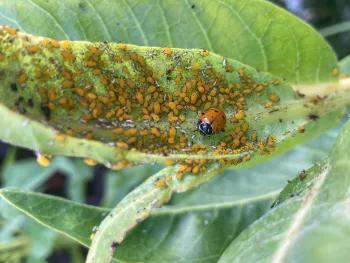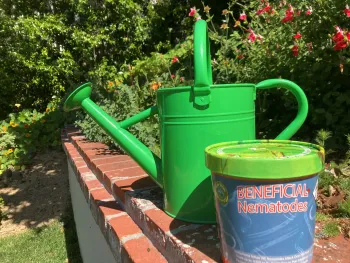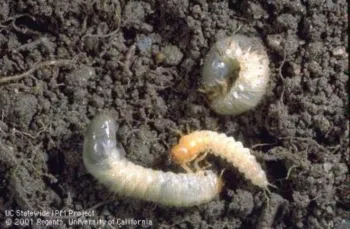It’s a bug eat bug world

Bugs are the creepy-crawly critters you find in your garden. Scientists divide them into groups. The largest group is insects, such as butterflies, bees, and beetles, which have three pairs of jointed legs and two pairs of wings. Other groups include spiders (arachnids), sowbugs (crustaceans), snails (mollusks), and worms (annelids). While some bugs damage our plants, many beneficial ones protect our gardens by eating the bad bugs.
Lady beetles are the most widely known predatory insect, both as adults and larvae. They form a pest patrol, feeding on plant-eating insects such as aphids. Aphids suck the juice out of our plants and secrete sweet honeydew that attract ants. Another insect, the green lacewing larva – sometimes called “aphid lions”- is a voracious predator capable of eating up to sixty aphids in an hour. Adult lacewings feed on flower nectar and help to pollinate our plants.

Another important garden ally is the nematode - a microscopic parasitic worm - that acts as biological control for many troublesome garden pests. These non-segmented round worms are too small to be seen with the naked eye, but they are a powerful pest management tool. They help control pests like slugs, ants, and beetles that would otherwise devastate your garden. They provide a way to avoid the use of artificial chemicals, such as pesticides. Note, these are not the same as “root knot” nematodes, which are plant parasites that damage the roots of specific plants.
There are over 20,000 known species of beneficial nematodes. To use them effectively, you must first identify the pest bothering your garden and then choose the corresponding nematode that targets it. You can purchase nematodes online or from your local garden center. Keep refrigerated until ready to use.
To apply, mix the nematodes with water and apply using a watering can, hose-end sprayer, or pump sprayer. Check the product label for the correct application rates. Quantities can range from the billions to the millions. For example, five million nematodes typically treat approximately 1,600 square feet.

A common lawn pest is the masked chafer. Its larvae – white C-shaped grubs – feed on grass roots, causing significant lawn damage and dead patches of grass. Even worse, raccoons come to feed on the grubs, tearing up large sections of grass in search of a meal. When beneficial nematodes are applied, they find the grubs and attack, releasing bacteria that kill the pests within 24 – 48 hours. The nematodes then use the grub body as a breeding ground, increasing their population and sustaining pest control.
The best time to apply nematodes is late summer or early fall when the soil temperature is above 60 degrees. Water the lawn before application to ensure the nematodes move through the soil effectively. Apply in the morning or evening for the best results. Keep the soil moist after application to allow the nematodes to establish. Two applications 2 weeks apart stages the life cycle for complete coverage.
Beyond grubs, nematodes can be effective in controlling fleas, cutworms, root weevils, mole crickets, codling moth larvae, thrips, armyworms, and fungus gnats. Each one has specific nematodes that can target these pests.
- Steinernema carpocapsae target cutworms, billbugs, crane flies, and lawn moths.
- Steinernema glaseri and Heterorhabditis bacteriophora target white grubs.
- Steinernema feltiae target thrips
The use of nematodes is safe for people, pets, and plants. Since nematodes are naturally occurring organisms, they do not leave harmful residue in the soil or groundwater.
Remember that certain plants attract and support our garden helpers, so they stick around and do their important job of controlling the bad bugs. Good bugs pollinate our food crops, enrich and fertilize the soil, eat our garbage, and provide food for wildlife. Some give us honey, wax, and silk. The bugs that are food for other animals and regulate the pest populations are our allies in maintaining the web of life in a healthy, earth-friendly garden.
By Alice Cason, July 12, 2025
